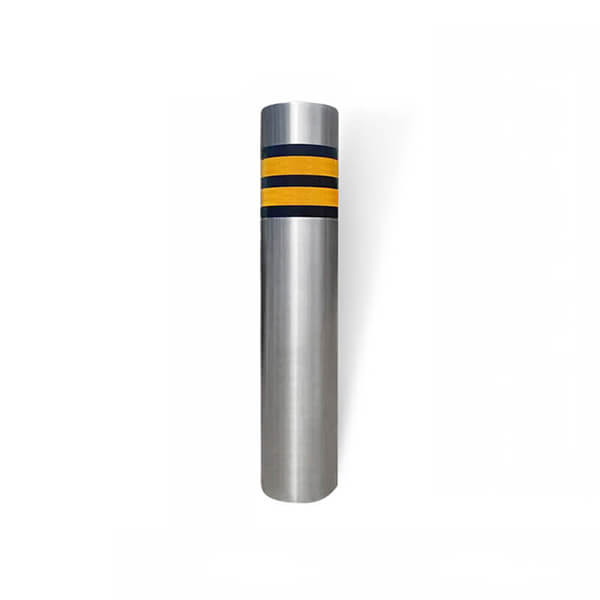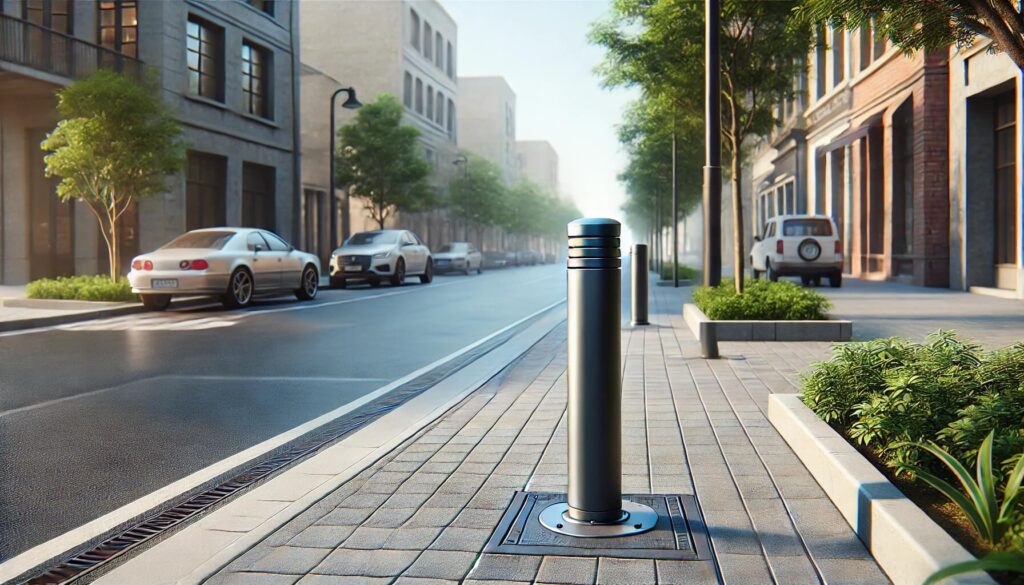Introducción
What is a Bollard?
A bollard is a sturdy, short, vertical post that is commonly used in urban environments to manage traffic and enhance safety. Originally, bollards were used in maritime contexts, where they served as posts for mooring boats to docks.
However, over time, their application has expanded significantly. Today, bollards are essential components in public and private spaces, providing both functional and aesthetic value.
Importance in Modern Urban Design
In modern urban design, bollards play a crucial role in ensuring the safety and organization of public spaces. They are used to:
- Guide vehicular and pedestrian traffic, preventing accidents and ensuring smooth movement.
- Protect buildings and infrastructure from vehicle collisions, whether accidental or intentional.
- Enhance the aesthetic appeal of public spaces through decorative designs that blend with the surrounding architecture.
- Create clear boundaries between pedestrian areas and roadways, improving overall safety for pedestrians.
Bolardos are not just practical tools; they are also a key element in the visual and functional design of urban landscapes. By understanding what a bollard is and its various applications, we can better appreciate its significance in our daily lives.
Types of Bollards
Fixed Bollards

Fixed bollards are permanently installed posts that are anchored securely into the ground. These bollards are designed for long-term stability and are commonly used in areas where consistent protection or traffic control is required. Some of the key features of fixed bollards include:
- Permanent installation, providing robust security.
- Ideal for protecting buildings, pedestrian areas, and sensitive zones.
- Often made from durable materials such as steel or concrete to withstand impact.
Removable and Retractable Bollards
Removable and retractable bollards offer flexibility in environments where access needs to be controlled temporarily. These bollards can be removed or lowered as needed, making them suitable for areas that require variable access. Key aspects of these bollards include:
- Flexibility to allow or restrict access on demand.
- Commonly used in parking lots, event spaces, and restricted zones.
- Available in both manual and automatic versions for ease of use.
Decorative Bollards
Decorative bollards combine functionality with aesthetic appeal. These bollards are often designed to enhance the visual landscape of public spaces while still providing the necessary protection and traffic control. Important features of decorative bollards include:
- Aesthetic designs that complement the surrounding architecture.
- Used in parks, pedestrian areas, and commercial spaces.
- Made from materials such as cast iron, bronze, or stainless steel to offer both beauty and durability.
Protective and Security Bollards
Protective and security bollards are specifically designed to safeguard buildings and public spaces from vehicle-based threats. These bollards are engineered to withstand high-impact collisions, making them essential in high-risk areas. Key characteristics include:
- High-impact resistance to prevent vehicle intrusions.
- Commonly installed around government buildings, airports, and other sensitive locations.
- May include features like anti-ram capabilities and reinforced construction.
Traffic Control Bollards
Traffic control bollards are used to manage and direct vehicular and pedestrian traffic. These bollards help to ensure safety and order by clearly delineating areas where vehicles are permitted. Some important features include:
- Guiding vehicles and pedestrians in busy urban areas.
- Often used at intersections, parking lots, and along sidewalks.
- Can be equipped with reflective materials or lights for visibility at night.
Materials Used in Bollard Construction
Steel and Stainless Steel Bollards

Steel and stainless steel bollards are among the most durable and commonly used materials in bollard construction. These bollards are known for their strength and ability to withstand significant impact, making them ideal for areas requiring high levels of protection. Key features include:
- Exceptional durability, capable of resisting high-impact collisions.
- Resistant to corrosion, especially in the case of stainless steel.
- Suitable for both security and aesthetic purposes, often used in urban and commercial environments.
Concrete Bollards
Concrete bollards offer substantial mass and stability, making them a preferred choice for high-security areas. These bollards are often used to protect buildings and public spaces from potential vehicle threats. Important characteristics include:
- Heavyweight and highly stable, providing effective vehicle deterrence.
- Often used in areas where maximum security is needed, such as government buildings and military installations.
- Can be molded into various shapes and sizes to meet specific design requirements.
Concrete Bollards
Aluminum bollards are a lightweight alternative to steel and concrete bollards, offering a balance between durability and ease of installation. These bollards are often used in areas where less impact resistance is required, but where aesthetics and functionality are still important.
Key points include:
- Lightweight, making them easier to install and relocate.
- Resistant to rust and corrosion, suitable for outdoor use.
- Often used in decorative applications or areas with low vehicle traffic.
Plastic and Flexible Bollards
Plastic and flexible bollards are cost-effective solutions that provide visual guidance and low-impact resistance. These bollards are ideal for areas where flexibility is necessary, such as parking lots or temporary construction zones. Notable features include:
- Flexibility that allows them to bend and return to their original shape after being struck.
- Cost-effective and easy to install, often used in temporary or low-risk settings.
- Available in various colors and designs to enhance visibility and aesthetic appeal.
Applications of Bollards
Urban Safety and Traffic Management
Bolardos play a crucial role in ensuring urban safety and managing traffic effectively. By preventing unauthorized vehicle access and guiding both vehicles and pedestrians, bollards contribute to a safer, more organized environment. Key applications in this area include:
- Preventing vehicles from entering pedestrian zones, reducing the risk of accidents.
- Managing traffic flow in busy areas, such as intersections and shopping districts.
- Enhancing pedestrian safety by creating clear boundaries between walkways and roadways.
Perimeter Security
Bolardos are essential for protecting the perimeter of buildings, public spaces, and other sensitive areas. By acting as physical barriers, they help to prevent unauthorized vehicle access and protect against potential threats. Key uses include:
- Securing government buildings, military installations, and airports.
- Protecting critical infrastructure such as power plants, data centers, and water facilities.
- Providing a first line of defense in high-risk areas prone to vehicle-based attacks.
Commercial and Retail Environments
In commercial and retail settings, bollards are often used to protect storefronts from accidental damage and deliberate attacks, such as ram-raiding. They also contribute to the overall safety and security of customers and staff. Common applications include:
- Placing bollards in front of store entrances to prevent vehicle intrusion.
- Using bollards to guide traffic in parking lots and loading areas.
- Enhancing the security of ATMs and other vulnerable assets.
Public Spaces and Parks
Bolardos serve both functional and decorative purposes in public spaces and parks. They help to organize pedestrian and vehicular traffic while adding to the aesthetic appeal of the area. Key uses in public spaces include:
- Marking pathways and entrances to parks, ensuring safe and orderly access.
- Protecting monuments, sculptures, and other public assets from vehicle damage.
- Enhancing the visual appeal of public spaces with decorative bollard designs.
Construction and Temporary Uses
In construction zones and during special events, bollards are used to create temporary barriers and guide traffic. These bollards are often removable or flexible, allowing for easy repositioning as needed. Key applications include:
- Setting up temporary traffic barriers around construction sites.
- Guiding vehicles and pedestrians during events such as festivals and parades.
- Providing a quick and effective way to manage access in dynamic environments.
How to Choose the Right Bollard
Assessing Security Needs
When selecting bollards for any environment, it’s essential to first assess the specific security needs of the area. Understanding the level of protection required will help determine the type and strength of the bollard needed. Key considerations include:
- The likelihood of vehicle intrusions, whether accidental or deliberate.
- The type of assets that need protection, such as storefronts, public buildings, or pedestrian areas.
- The potential threat level, which might vary depending on the location and its importance.
Material Considerations
The choice of material for bollards greatly influences their durability, impact resistance, and overall appearance. Depending on the environment and the specific application, different materials may be more suitable. Key factors to consider include:
- Steel and Stainless Steel: Ideal for high-impact protection and long-term durability.
- Concrete: Best for high-security areas requiring substantial mass and stability.
- Aluminum: A good choice for lightweight, decorative applications.
- Plastic and Flexible Materials: Suitable for temporary installations and areas with lower security needs.
Installation and Maintenance
Proper installation is crucial for the effectiveness of bollards. Ensuring that bollards are securely anchored and positioned correctly will maximize their protective capabilities. Additionally, ongoing maintenance is necessary to keep bollards in good condition. Important steps include:
- Selecting the right installation method based on the type of bollard and the environment (e.g., embedded in concrete or bolted to the ground).
- Regularly inspecting bollards for signs of wear, damage, or corrosion, especially in outdoor or high-traffic areas.
- Cleaning and repainting as needed to maintain both functionality and aesthetic appeal.
Compliance with Local Regulations
Before installing bollards, it’s essential to ensure that the design and placement comply with local regulations and safety standards. This helps to avoid legal issues and ensures that the bollards are effective in their intended role. Consider the following:
- Understanding the local building codes and safety regulations that apply to bollard installation.
- Ensuring that bollards meet any required impact resistance or crash test standards, particularly in high-risk areas.
- Consulting with local authorities or experts if necessary to ensure full compliance.
FAQs and Conclusion
Preguntas frecuentes
What are bollards used for?
Bollards are primarily used to control and guide traffic, protect buildings and pedestrians from vehicles, and enhance the safety and aesthetics of public spaces. They serve as barriers to unauthorized vehicle access and help define areas where vehicles are not permitted.
What is a bollards post?
A bollard post is a sturdy, vertical structure that is installed in the ground to prevent vehicles from entering restricted areas or to provide guidance for traffic and pedestrians. Bollard posts come in various materials and designs, depending on their intended use.
What is a security bollard?
A security bollard is a type of bollard specifically designed to provide protection against vehicle-based threats.
These bollards are often made from high-impact-resistant materials and are installed in areas that require enhanced security, such as government buildings, airports, and commercial zones.
How do I maintain bollards?
Maintaining bollards involves regular inspections for signs of wear, damage, or corrosion. Cleaning, repainting, and checking the integrity of the installation are also important to ensure that the bollards remain effective and visually appealing.
Conclusión
Understanding what is a bollard and its various applications is essential for anyone involved in urban planning, security, or traffic management. Bollards are versatile tools that not only enhance safety but also contribute to the visual appeal of public and private spaces.
By choosing the right type of bollard and ensuring proper installation and maintenance, you can effectively protect assets, guide traffic, and create a safer environment for everyone.




